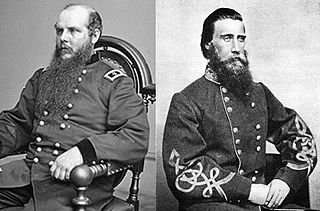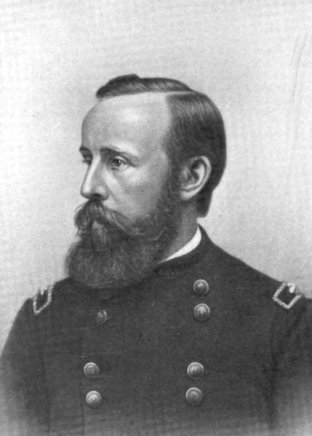
The Army of Tennessee was the principal Confederate army operating between the Appalachian Mountains and the Mississippi River during the American Civil War. It was formed in late 1862 and fought until the end of the war in 1865, participating in most of the significant battles in the Western Theater.

The Army of the Tennessee was a Union army in the Western Theater of the American Civil War, named for the Tennessee River.

The Battle of Resaca, from May 13 to 15, 1864, formed part of the Atlanta Campaign during the American Civil War, when a Union force under William Tecumseh Sherman engaged the Confederate Army of Tennessee led by Joseph E. Johnston. The battle was fought in Gordon and Whitfield Counties, Georgia, and is generally viewed as inconclusive.

The Atlanta campaign was a series of battles fought in the Western Theater of the American Civil War throughout northwest Georgia and the area around Atlanta during the summer of 1864. Union Maj. Gen. William Tecumseh Sherman invaded Georgia from the vicinity of Chattanooga, Tennessee, beginning in May 1864, opposed by the Confederate general Joseph E. Johnston.

The Battle of Kennesaw Mountain was fought on June 27, 1864, during the Atlanta Campaign of the American Civil War. It was the most significant frontal assault launched by Union Maj. Gen. William T. Sherman against the Confederate Army of Tennessee under Gen. Joseph E. Johnston, ending in a tactical defeat for the Union forces. Strategically, however, the battle failed to deliver the result that the Confederacy desperately needed—namely a halt to Sherman's advance on Atlanta.
The Battle of Averasborough or the Battle of Averasboro, fought March 16, 1865, in Harnett and Cumberland counties, North Carolina, as part of the Carolinas Campaign of the American Civil War, was a prelude to the climactic Battle of Bentonville, which began three days later.

The Battle of Wilmington was fought February 11–22, 1865, during the American Civil War, mostly outside the city of Wilmington, North Carolina, between the opposing Union and Confederate Departments of North Carolina. The Union victory in January in the Second Battle of Fort Fisher meant that Wilmington, 30 miles upriver, could no longer be used by the Confederacy as a port. It fell to Union troops after they overcame Confederate defenses along the Cape Fear River south of the city. The Confederate General Braxton Bragg burned stores of tobacco and cotton, among other supplies and equipment, before leaving the city, to prevent the Union from seizing them.
The Army of the Ohio was the name of two Union armies in the American Civil War. The first army became the Army of the Cumberland and the second army was created in 1863.

The Battle of Spring Hill was fought November 29, 1864, at Spring Hill, Tennessee, as part of the Franklin-Nashville Campaign of the American Civil War. The Confederate Army of Tennessee, commanded by Lt. Gen. John Bell Hood, attacked a Union force under Maj. Gen. John M. Schofield as it retreated from Columbia through Spring Hill. Because of a series of command failures, the Confederates were unable to inflict serious damage on the Federals and could not prevent their safe passage north to Franklin during the night. The next day, Hood pursued Schofield and attacked his fortifications in the Battle of Franklin, resulting in severe Confederate casualties.

The Franklin–Nashville campaign, also known as Hood's Tennessee campaign, was a series of battles in the Western Theater, conducted from September 18 to December 27, 1864, in Alabama, Tennessee, and northwestern Georgia during the American Civil War.

The siege of Corinth was an American Civil War engagement lasting from April 29 to May 30, 1862, in Corinth, Mississippi. A collection of Union forces under the overall command of Major General Henry Halleck engaged in a month-long siege of the city, whose Confederate occupants were commanded by General P.G.T. Beauregard. The siege resulted in the capture of the town by Federal forces.

The Battle of Dallas was an engagement during the Atlanta Campaign in the American Civil War. The Union army of William Tecumseh Sherman and the Confederate army led by Joseph E. Johnston fought a series of battles between May 25 and June 3 along a front stretching northeast from Dallas toward Acworth, Georgia. At Dallas a probe launched by William B. Bate's and William Hicks Jackson's Confederate divisions accidentally turned into a full-scale assault against the defenses of John A. Logan's XV Corps. The attack was driven off with heavy Confederate losses. The previous Union defeats at New Hope Church and the Pickett's Mill are sometimes considered with Dallas as part of one battle.

The Carolinas campaign, also known as the campaign of the Carolinas, was the final campaign conducted by the Union Army against the Confederate Army in the Western Theater of the American Civil War. On January 1, Union Maj. Gen. William T. Sherman advanced north from Savannah, Georgia, through the Carolinas, with the intention of linking up with Union forces in Virginia. The campaign culminated in the defeat of Confederate Gen. Joseph E. Johnston's army at the Battle of Bentonville, and its unconditional surrender to Union forces on April 26, 1865. Coming just two weeks after the defeat of Robert E. Lee's army at the Battle of Appomattox Court House, it signaled that the war was effectively over.

The western theater of the American Civil War encompassed major military operations in the states of Alabama, Georgia, Florida, Mississippi, North Carolina, Kentucky, South Carolina and Tennessee, as well as Louisiana east of the Mississippi River. Operations on the coasts of these states, except for Mobile Bay, are considered part of the Lower Seaboard Theater. Most other operations east of the Appalachian Mountains are part of the eastern theater. Operations west of the Mississippi River took place in the trans-Mississippi theater.

During the American Civil War, North Carolina joined the Confederacy with some reluctance, mainly due to the presence of Unionist sentiment within the state. A popular vote in February, 1861 on the issue of secession was won by the unionists but not by a wide margin. This slight lean in favor of staying in the Union would shift towards the Confederacy in response to Abraham Lincoln's April 15 proclamation that requested 75,000 troops from all Union states, leading to North Carolina's secession. Similar to Arkansas, Tennessee, and Virginia, North Carolina wished to remain uninvolved in the likely war but felt forced to pick a side by the proclamation. Throughout the war, North Carolina widely remained a divided state. The population within the Appalachian Mountains in the western part of the state contained large pockets of Unionism. Even so, North Carolina would help contribute a significant amount of troops to the Confederacy, and channel many vital supplies through the major port of Wilmington, in defiance of the Union blockade.

Edward Harland was a Union general during the American Civil War. He was associated with early battles of the IX Corps as well as Union involvement in North Carolina and the Tidewater region of Virginia.

The Battle of Bentonville was fought in Johnston County, North Carolina, near the village of Bentonville, as part of the Western Theater of the American Civil War. It was the last battle between the armies of Union Maj. Gen. William T. Sherman and Confederate Gen. Joseph E. Johnston.

The Army of the South was a Confederate field army during the final months of the American Civil War. Formed from a collection of Confederate commands during the Carolinas Campaign, it was engaged in only one major battle, the Battle of Bentonville in March 1865. During the following month, it was reorganized under the name of the Army of Tennessee.
The 130th Regiment Indiana Infantry was an infantry regiment that served in the Union Army during the American Civil War.

The 85th New York Infantry Regiment was an infantry regiment in the Union Army during the American Civil War.


















